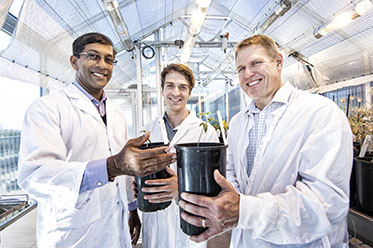|
Developing drought tolerant mungbean
Brisbane, Queensland, Australia
April 28, 2014

Professor Sagadevan Mundree and PhD researcher Michael Dodt explain their drought-tolerant
mungbean research to Australian Mungbean Association President Rob Anderson.
Mungbean industry representatives at the Queensland University of Technology (QUT) have had a sneak peak at the research which could see growers producing hardier and more drought-tolerant varieties of the pulse in the future.
The Australian Mungbean Association is meeting at QUT over the next two days and will be addressed by the researcher in charge of the project, Professor Sagadevan Mundree.
Professor Mundree, who is also deputy director of QUT's Centre for Tropical Crops and Biocommodities, took the industry representatives on a tour of QUT's greenhouse this morning where they saw a variety of tropical pulses the researchers are working with, including mungbean.
PhD student Michael Dodt explained to the group the three key elements being pursued to create hardier varieties of mungbean.
He said a stronger, deeper root system was integral to the development of new drought tolerant varieties.
"We are working to enhance the root architecture of the plant to not only make the root system deeper but have more volume and spread over a wider area so it can access more water and nutrients," he said.
"Our work starts in the lab, introducing new chemical pre-treatments to mungbean seeds, before testing and growing a selection in our greenhouse. We now have field trials underway at the Hermitage Research Station near Warwick."
Mr Dodt said researchers were also using computer modelling software to determine the best or highest yielding varieties of mungbean for different growing environments.
He said the Agricultural Production Systems Simulator (APSIM) was gaining in popularity internationally and had a lot to offer Australian growers.
"Achieving the best yield possible depends on many variables and includes plant genetics, the growing environment and management of crops," he said.
"This program has been used to great success in relation to growing sorghum and has the potential to provide great benefits to mungbean growers, identifying advances in genetics and determining the best type of mungbean for a specific environment."
He also said the university was developing a Nested Association Mapping population which would diversify the gene pool of mungbean breeding material in Australia.
"This will help us to identify drought tolerant markers from within these crop varieties."
Professor Mundree said pulses, such as mungbean, were an important source of protein and as the world's population increased the current dependence on animal protein would not be sustainable.
He said mungbean were grown throughout central Queensland and parts of New South Wales and the industry was worth $60-$70 million.
"By developing more drought tolerant varieties of mungbean we will not only secure the future of this industry in the face of climate change but potentially open up more land for mungbean cultivation.
"A world food shortage is a realistic forecast and this research will put Australia in a position to do something positive and concrete and be part of a solution."
The research forms part of a wider program which has attracted $4.8 million from the Queensland Government.
More news from: Queensland University of Technology
Website: http://www.qut.edu.au Published: June 2, 2014 |
|
The news item on this page is copyright by the organization where it originated
Fair use notice |